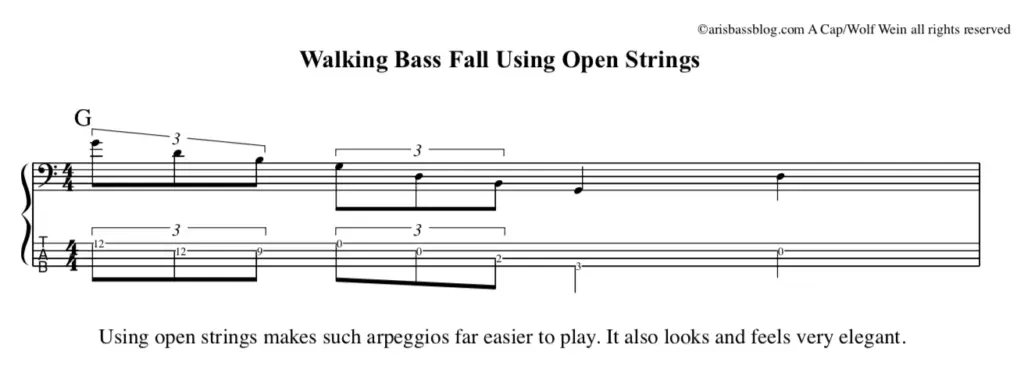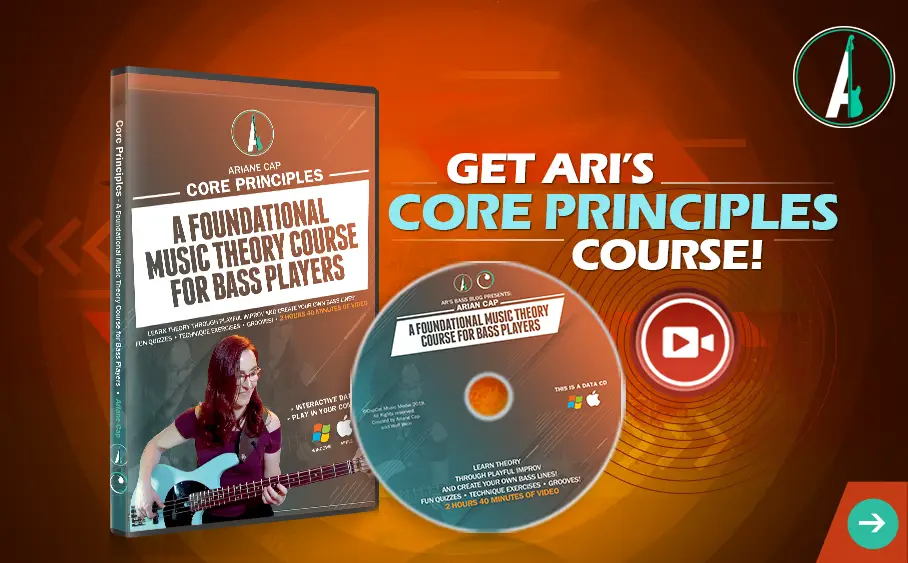Ari, I am cheating!
I am often amazed at what my students think constitutes “cheating” and hence dutifully try to avoid.
Let’s clear up some misunderstandings:
- It will help you stop shooting yourself in the foot
- Allow me to take a load off your shoulders
Here are the top 6 “cheating” myths I keep hearing:
#1 – Using open strings
I get it: your bass doesn’t have a zero fret, so you may have concerns about consistency in tone between fretted notes and open string notes. Truth is, notes do sound differently for a variety of reasons… and that’s okay! Embrace the organic sound of the instrument and instead work on your technique! Specifically on consistent timing, tone length, and tone volume. Learn optimal finger placement with your left hand fingers and pay attention to producing an even sound from your plucking with your right hand. This is so much more important than fretting (or, rather, NOT fretting!) the occasional open string!
Plus, sometimes open strings truly are the only option.
A few examples:
- The open string is a must here:
- Upright players love using the open string. Try a hip drop like this without open strings – it would be much harder to play and kill all the charm:

- Bakhiti Kumalo’s iconic bass lick in Paul Simon’s “Call Me Al” uses three open strings:
- Open strings can be a lifesaver when you are sight reading and need to change positions! Use them!
- And they sound great for chords! Listen to this example from my Duo OoN where I move triads on two strings up and down while pedaling the open D string:
Play a tune like: Play that Funky Music. Ever been bothered by the sound of that open E string? See, I thought so!
Bottom line: Don’t feel bad playing an open string!
⇒ Using an open string… Not cheating!
NOTE: If you are using the open A because it’s the only A you can find on the fretboard, well that’s another matter. In that case, I prescribe the Creative Notefinder exercise from my book on page 12. You pick a different note each week, do the drill for five minutes daily and soon enough you won’t have any problem finding notes all over the fretboard!
HAPPY FACT: I think they are called open strings because you need to remain open to them!
#2 – Using a metronome
Some claim that using a metronome for practicing hinders the development of a good internal sense of timing. As a generalized statement, I find this completely false. When incorporated correctly, the steady beat can accomplish the opposite. It will fine tune your timing, and it provides unflinching and immediate feedback.
My upcoming book on the systematic study of musical patterns contains an extended section on why, how, and when to use a metronome (and when to skip it). There are so many benefits to using one! So use it! Focus on it carefully while playing and try to “kill the click”- that is, make the sound of the click and the bass note one singular sound. It’s delicious when you are on top of the beat like that! Do not deprive yourself of this training and experience!
If you are unsure about the precision of the subdivisions of a groove, set it in your metronome and work on matching it exactly. It will help you to steady difficult and syncopated rhythms. (In my new book you’ll get to know our new sidekick, Skippy, who is a little metronome with an attitude! Skippy is highly sensitive – don’t accuse him of cheating or anything other than being the amazing superhero he is…)
⇒ Using a metronome… Not cheating!
#3 – Writing down fingerings or marking your chart
Let’s say you keep forgetting the accidental in bar 3. Or you are struggling with a new section and rather than slow down to figure out the issue and write it down so you remember it – you clench your teeth and hope that when you get to that bar the umpteenth time you will just magically nail it.
Please stop. Literally. Stop playing, lower the bass, pick up a pencil, and diagnose the problem. Write in that elusive sharp or flat! Test out some good fingerings. Find the best one and write it down! Keep tweaking until it is perfect (that’s why you use pencil, not ink!). Pro musicians’ charts are full of all sorts of markings, including phrasing, parts, solo order, etc. These markings are proof of proper practice, which includes analyzing, experimenting, and refining. Rationalizing your way out of practicing properly – now that’s cheating! Instead: mark proudly, then play loudly!
⇒ Writing down fingerings and marking up a chart… Not cheating!
#4 – Practicing
This myth goes something like this:
You must never practice. The ultimate secret is to know everything right off the bat! From the first time you attempt it, you must nail it flawlessly. If there is something that sounds off, ignore it and keep going. “If you pretend it did not happen, it didn’t happen.”
Practicing is admitting weakness. Practicing is cheating, pros never practice! Only those without talent practice. Mistakes add character. Don’t ever be caught practicing!!
Okay, I hope this made you laugh.
Do practice. Thoughtfully and often! Break musical pieces into small bits – optimize fingering, phrasing, interpretation. Loop these bits. Then loop bigger bits. Have a plan and have benchmarks to meet. Pros practice, so should you.
Practicing is like being on a treasure hunt – you must find the gold by looking for it. Be your own coach and cheer yourself on!
⇒ Practicing… Not cheating!
#5 Using a pick. Or your fingers.
There is no one “right answer” to this. The right tool is the one that produces the right sound for the song or segment, dig? I have very little patience for these discussions. Neither fingers nor picks are superior, nor are they “cheating”. They are tools to get a certain sound or to play certain lines. Expand your playing techniques and get more gigs!
⇒ Pick or no pick… Not cheating!
#6 Playing a five-string, or four-string, or six-string
Let’s turn to the YouTube comment section for some interesting and familiar quotes:
Video 1: “You must be really good – you play six string!!”
Video 2: “Wow, you are awesome, you played this piece on a four string!!”
For crying out loud, stop it! Each string combination has unique challenges and benefits. Choosing the best tool for the job is not cheating! And by the way, wielding a mighty six-string axe will not cover up for bad playing, nor will a four-string make you sound more “authentic”. If you have a personal preference – high five! (You decide if this is a pun!) But don’t insinuate your choice is the only valid one or that somehow you are cheating by choosing one over the other. (Although trying to get bragging rights because you are wielding a sixer just to look more serious might count as such!) Love the player, not the string number.
⇒ Number of strings on a bass… Not cheating!
Ain’t Gonna Lie…
…some of these are hard to hear and even harder to eradicate. I am sad to see limiting beliefs hold players back. Not only are you shooting yourself in the foot by thinking a useful thing is cheating, but you are also really putting an unnecessary burden on yourself. Don’t! Instead, go practice and enjoy the progress you are making!
You might also like:
A Little Trick that works Wonders
Stop! Don’t Practice a Mistake!


